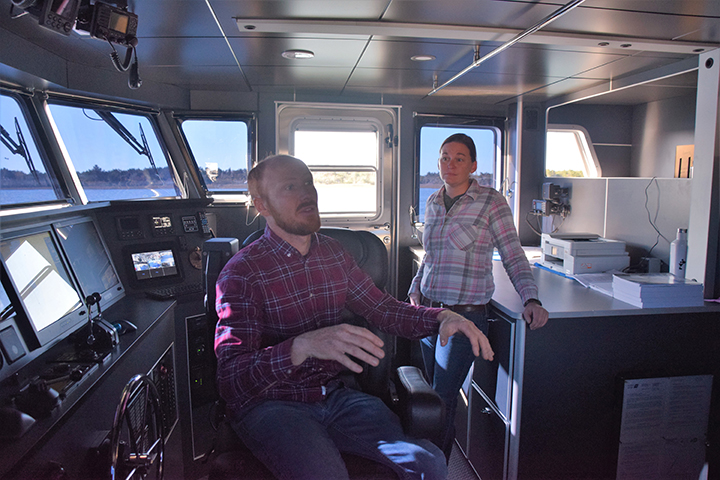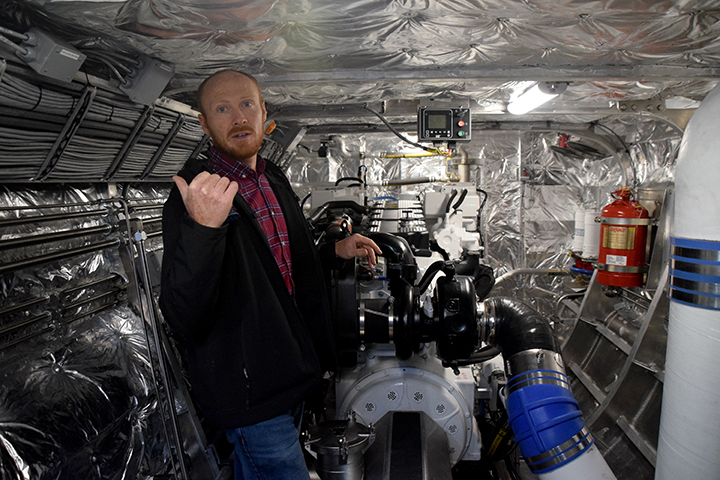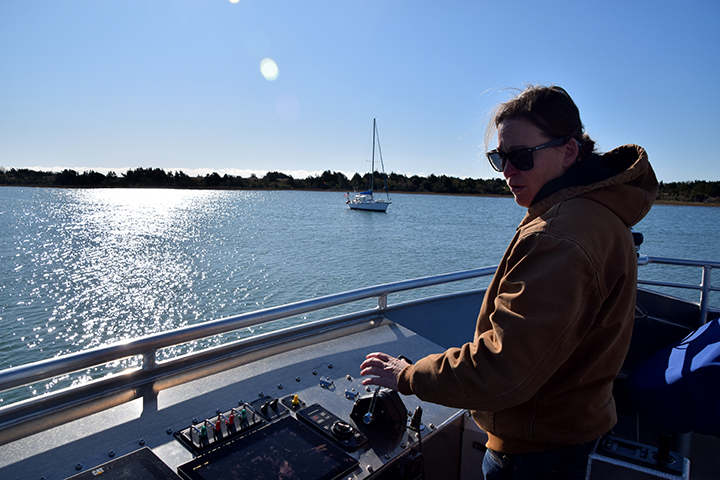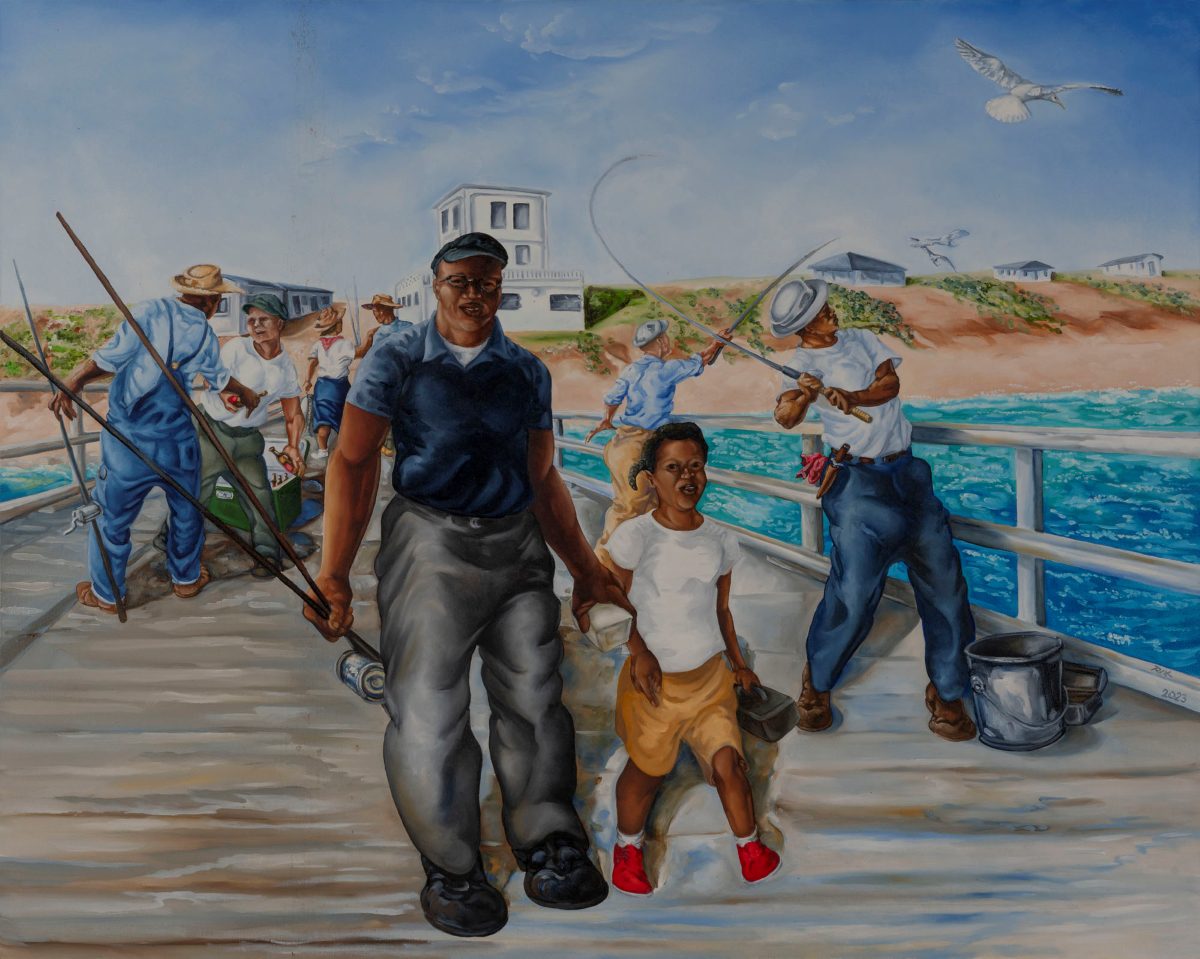
BEAUFORT – For the next few weeks, the new research vessel Shearwater has joined the sailboats, cabin cruisers, catamarans and fishing boats normally found at the town docks this time of year, but this “classroom at sea” and its crew will soon embark on its first big trip.
The vessel, which was completed this fall and made its maiden voyage last month, is Duke University Marine Lab’s 77-foot catamaran, and will head south at the start of the spring semester.
Supporter Spotlight
The Shearwater is equipped with state-of-the-art gear for research and navigation, has a full kitchen, space to accommodate up to 15 on overnight trips, five separate heating and air conditioning systems that can be controlled independently, one restroom and shower and is compliant with the federal Americans with Disabilities Act.
Matthew Dawson, the Shearwater’s captain, told Coastal Review Online during a media tour last week that the vessel made its first trip from Miami north, pulling into Beaufort the afternoon of Nov. 26.
While there are plans to take the vessel out on short trips in the coming weeks, the Shearwater will head back to Miami in January to meet a Duke University Marine Lab biological oceanography class. The crew will pick up the students there for the 10-day trip, Dawson said.
Zackary Johnson, associate professor of molecular biology in marine science, is leading the class with ports of call at Key West, Dry Tortugas National Park, Fort Myers, the Everglades and Miami. Coursework will include hands-on sampling and data collection, real-time data analyses, lectures, videos and companion reading, according to Duke University.
“The opportunity to teach and learn by practicing science in the field, under real-world situations is really exciting,” Johnson told Coastal Review Online. “The Shearwater is both a research and teaching vessel, and having all of the capabilities for research will enable first-rate educational experiences. Going to sea is such an amazing experience, and there are always unexpected opportunities and things to see. I am honored to be able to be the first professor to lead a trip on the vessel.”
Supporter Spotlight
Johnson said that although he has brought many students, both undergraduate and graduate, to the field, this will be the first time that he’s had the opportunity to dedicate a research vessel entirely for an education mission.
“I’m hoping that students come away from the trip with the sense of excitement and an appreciation for the opportunities that on-the-water oceanographic sampling provides,” Johnson said. “For me, it transformed my interests and ultimately caused me to head down the path of becoming a biological oceanographer. I also hope that the students use this opportunity to learn how challenging field oceanographic research can be, but that it presents unique opportunities to understand the environment.”
Set up for science
Last week during the media tour, Dawson, crew and the media crowded inside the catamaran, near where the dry and wet lab areas are located by the exit to the stern work deck. He explained that “Everyone who comes on the boat will have different equipment and requirements and they need to be able to set it up as quickly and as securely as possible.”
Both the dry and wet labs were set up to accommodate most needs. The dry lab has standard methods to secure equipment to the countertop, such as computers, that shouldn’t get wet. The wet lab area has an uncontaminated seawater supply, which will enable researchers to collect water samples while the vessel is moving, and equipment that constantly monitors salinity and temperature of the water.
“If we’re going back and forth across the Gulf Stream, we can be continuously monitoring the properties of the water as we go. That can tie into whatever other data people might be working on. Maybe they’re counting fish or looking at the seabed, but they can bring in temperature, what the currents might be doing, salinity,” Dawson explained.
Also on board to meet the media was Marine Operations Manager John Wilson and Tina Thomas of Beaufort, the marine technician for the Shearwater.
Thomas is in charge of setting up all the science acquisition systems and water sampling equipment.
Gesturing to a group of matte-black canisters in a round metal frame tucked in a corner of the dry lab area, “It’s a CTD,” she said, which are a package of electronic instruments that measure conductivity, temperature and depth.
“We can put this down in a water column on a cable and it can measure real-time salinity, temperature and it will measure the amount of light that penetrates the water column. And each one of these is a water bottle, so we can put it down and can be opened and closed at any depth, and then we can get a sample that you can bring into the lab to filter, kind of like ground truthing.”
The CTD will be lowered into the water using an A-frame on the stern work deck, most of which is dotted with strategically placed bolts. Dawson said that the University-National Oceanographic Laboratory System, or UNOLS, the national research vessel fleet, has a standard bolt pattern that’s a 2-foot by 2-foot grid, “so that people who do research on any of these ships can set up their gear to bolt down on any boat, on the deck.”
UNOLS is an organization of 59 academic institutions and National Laboratories involved in oceanographic research and joined for the purpose of coordinating oceanographic ships’ schedules and research facilities. The track setup on the counter in the dry lab also adheres to UNOLS standards, so any user can just show up with their equipment and go to work, Dawson said.
The Shearwater’s pilot room is where Dawson feels most at home. It’s also loaded with high-end equipment.
“The whole boat is small but functional, therefore easier and cheaper to operate but still achieving fairly aggressive goals,” Dawson said.

Experienced crew
Dawson said he grew up on the west coast of Scotland, in a small community only accessible by boat and his father built boats. “I’ve been running boats my whole life,” he said.
Dawson worked on fishing boats as a high school student and also while he was getting his degree in marine biology at the University of St Andrews in Scotland. Later, he worked as a fisheries biological technician on commercial fishing boats in Alaska and with National Marine Fisheries Service in Kodiak, Alaska.
When you get to a certain point in the biology career track, you often work as a technician for a few years then move up into biologist role, Dawson said. “I came to the realization that most biologist roles are office based and a management role,” he added, which “wasn’t my strength.”
The experience led him to spend a summer in Alaska, working on a charter research vessel as mate and engineer on a marine debris cleanup around Kodiak Island. “That was where I realized there was a career in running research vessels.”
The skipper and owner he worked for encouraged him. Instead of going for a master’s and pursuing the biologist route, “I got my captain’s license, and I’ve been pursuing this, basically, for four or five years,” he said as he gestured around the Shearwater’s pilothouse.
After Alaska, Dawson worked with the state Division of Marine Fisheries in Morehead City as a technician, and later as captain on a vessel building artificial reefs.
“When we were first looking at places to move from Alaska, we were looking for rural communities on the coast that has marine research. This really fits all of those areas,” he said of his relocation to Carteret County. “And so I looked at the research institutes and who had boats.”
While working full time at the Division of Marine Fisheries, Dawson also worked part time on the Duke Lab’s previous research vessel, the Susan Hudson, which was retired in 2014, leaving very little work for a part-time captain.
Dawson was involved in the Shearwater’s development. “It was always my goal to be captain on this boat,” he said, but he needed to upgrade his license to match the new vessel’s tonnage. To do that, he went back to Alaska to work on a 100-foot Bering Sea crabber that was being set up as a research vessel. The work took him 1,200 miles out to sea west of Anchorage, supporting helicopter operations for a volcano laboratory.
“So through that, I upgraded my license and was appropriately licensed for this vessel,” Dawson said.
Thomas, the marine technician, said she had previously worked on the Cape Hatteras, a 135-foot research vessel that the Duke Lab operated and managed for the National Science Foundation that was sold to Cape Fear Community College in 2013. “I joined a technician pool for UNOLS vessels and was a contractor that floated with different research vessels in the fleet. When I heard they were building this research vessel, it sounded nice to come back home.”
She said that although she enjoyed traveling during the past six years and gained experience, “I want to feel connected to the community again. I grew up here, this is home.”

Multiple roles
“The research vessel industry has traditionally been split between small vessels that that did day trips and big ships, of which the Hatteras was on the small end but definitely a ship,” Dawson explained.
Vessels the size of the Cape Hatteras usually have a crew of about nine and are expensive to operate but also allow crews to remain offshore for weeks. The problem is that it takes from $13,000 to $15,000 per day to operate. Some of the larger ships cost as much as $20,000 to $40,000 per day, much of which goes to pay the crew.
Dawson said, “We now have the ability to go quite a lot faster, and with this vessel, we think that we’ll be able to achieve maybe 50 to 70 percent of the work that some of these larger research vessels do, but quicker, cheaper and maybe simpler.”
But with the Shearwater, “We’re looking at maybe $4,000 for 24 hours … it’s a smaller boat and we are able to run with two crew.”
The Shearwater is designed to be easily maintained and a more compact unit, so each of its two-person crew serves multiple roles.
Dawson and Thomas are the full-time crew for the Shearwater.
I’m captain and engineer and Tina is mate, or second in command, and marine technician, deckhand, instructor,” Dawson said, “Because we’re trying to run fairly shorthanded, we really require a lot of breadth in the two primary people.”
Wilson will join to help on longer trips, like the one to Miami in January.
Below the stern deck are the two engine rooms. From inside one of the engine rooms, Dawson noted the Shearwaters’ two Caterpillar engines, which each are rated at 800 horsepower.
“Everything in here is mirrored on the other side,” he said, adding the two main generators provide electricity when the vessel is away from the dock.
Dawson said that the vessel runs on diesel and uses about 10 gallons an hour at the efficiency cruise, which is 10 knots, and when the Shearwater is at its fast cruise, around 24 knots, the vessel can use up to 70 gallons an hour. Depending on the mission, it may be worth going fast to get everything done in one day rather than two or three.
The vessel is also available for charter, Dawson explained. Dawson expects about half of the work to be through Duke University, but other research institutions and contractors have expressed interest in chartering the Shearwater.
Filling a gap
Duke Marine Lab Director Andy Read told Coastal Review Online that having the Shearwater “exponentially increases our ability to get students out on the water and teach them about the ocean and the vital role it plays in the health of our planet and the species that live here.”
The Shearwater also provides an opportunity to engage with more community partners on local conservation and education efforts.
“With four marine science facilities — Duke, the University of North Carolina, N.C. State and North Carolina Sea Grant — along the same North Carolina shoreline, our region is widely known as a hub of ocean research, education and conservation but we haven’t had a large vessel permanently stationed here since the retirements of the R/V Cape Hatteras and R/V Susan Hudson in 2012 and 2014. This new research vessel fills that gap,” said Read.
The Shearwater was funded with an $11 million gift in 2017 to the university, All American Marine in Bellingham, Washington, built the research vessel and launched it there Sept. 26. Duke took over ownership of the vessel Oct. 6 and had the vessel transported on a larger ship from the West Coast through the Panama Canal, arriving in southern Florida in mid-November.







